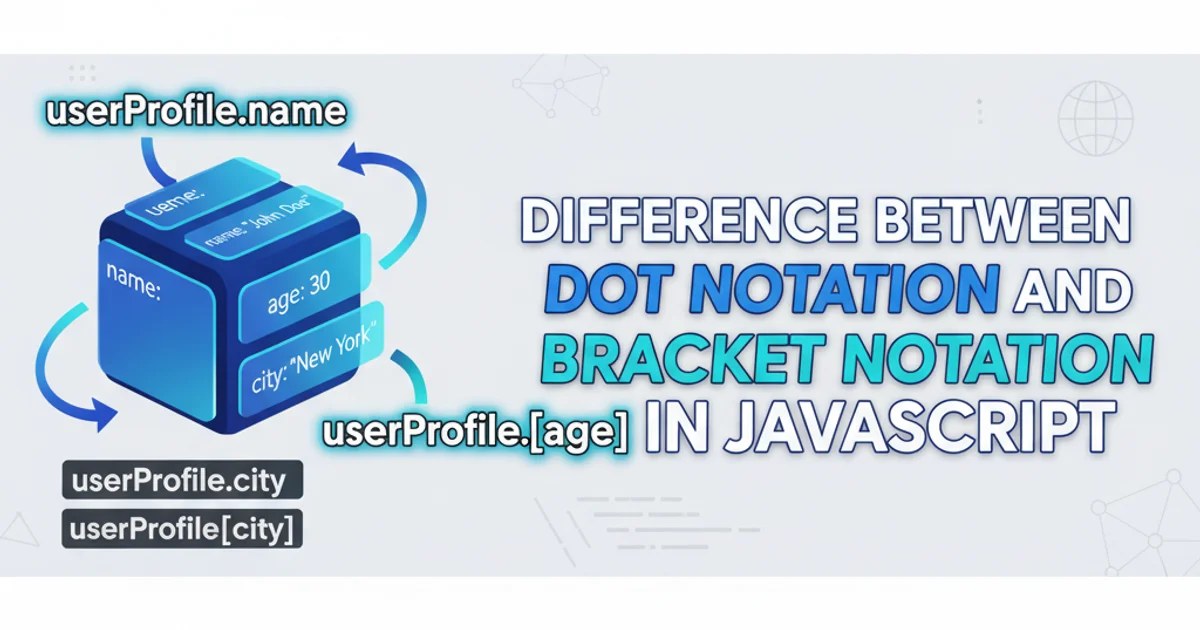difference between dot notation and bracket notation in javascript
Categories:
Dot Notation vs. Bracket Notation in JavaScript: A Comprehensive Guide

Explore the fundamental differences and use cases of dot notation and bracket notation for accessing object properties in JavaScript, with practical examples and best practices.
In JavaScript, objects are fundamental data structures used to store collections of key-value pairs. To interact with these properties, you have two primary syntaxes: dot notation (.) and bracket notation ([]). While they often achieve the same result, understanding their nuances and when to use each is crucial for writing robust and flexible JavaScript code. This article will delve into the specifics of both notations, highlighting their strengths and weaknesses.
Understanding Dot Notation
Dot notation is the more common and generally preferred method for accessing object properties when the property name is a valid, known identifier. It's concise, readable, and often leads to cleaner code. However, it has limitations that make bracket notation necessary in certain scenarios.
const person = {
name: 'Alice',
age: 30,
city: 'New York'
};
// Accessing properties using dot notation
console.log(person.name); // Output: Alice
console.log(person.age); // Output: 30
// Assigning a new value
person.age = 31;
console.log(person.age); // Output: 31
Basic property access and assignment using dot notation.
Understanding Bracket Notation
Bracket notation provides more flexibility than dot notation. It allows you to access properties using variables, strings that are not valid identifiers (e.g., containing spaces or special characters), or even numeric indices for array-like objects. This dynamic nature makes it indispensable for many programming patterns.
const car = {
make: 'Toyota',
model: 'Camry',
'top speed': 200,
'year-made': 2020
};
// Accessing properties using bracket notation
console.log(car['make']); // Output: Toyota
console.log(car['top speed']); // Output: 200 (property name with space)
const propName = 'model';
console.log(car[propName]); // Output: Camry (property name from a variable)
// Assigning a new value
car['year-made'] = 2021;
console.log(car['year-made']); // Output: 2021
Property access and assignment using bracket notation, including dynamic property names.
Key Differences and Use Cases
The choice between dot and bracket notation often comes down to the specific context and the nature of the property name. Here's a breakdown of their primary distinctions and when to favor one over the other.
flowchart TD
A[Access Object Property] --> B{Is property name a valid identifier?}
B -- Yes --> C{Is property name known at coding time?}
C -- Yes --> D[Use Dot Notation (.property)]
C -- No --> E[Use Bracket Notation (['property'])]
B -- No --> E
E --> F{Is property name dynamic (variable)?}
F -- Yes --> G[Use Bracket Notation ([variable])]
F -- No --> H[Use Bracket Notation (['invalid-name'])]Decision flow for choosing between dot and bracket notation.
Practical Scenarios for Bracket Notation
While dot notation is the default for readability, bracket notation shines in situations requiring dynamic property access or when dealing with unconventional property names. Here are some common scenarios:
1. Dynamic Property Access
When the property name is not known until runtime, perhaps coming from user input, an API response, or a loop, bracket notation is essential. You can store the property name in a variable and use that variable inside the brackets.
2. Property Names with Special Characters or Spaces
If a property name contains spaces, hyphens, or other characters that are not valid in a JavaScript identifier (e.g., my-property, first name), you must enclose the property name in quotes within bracket notation.
3. Accessing Array Elements (Objects as Associative Arrays)
While arrays have their own [] syntax for numeric indices, objects can sometimes be treated like associative arrays where keys are strings. Bracket notation is used here to access properties by their string keys.
const user = {
id: 1,
'user-name': 'john_doe',
'email address': 'john@example.com'
};
// Dynamic access
const key = 'id';
console.log(user[key]); // Output: 1
// Accessing properties with special characters
console.log(user['user-name']); // Output: john_doe
console.log(user['email address']); // Output: john@example.com
// Iterating over properties dynamically
for (const prop in user) {
console.log(`${prop}: ${user[prop]}`);
}
/* Output:
id: 1
user-name: john_doe
email address: john@example.com
*/
Examples demonstrating dynamic property access and handling special characters with bracket notation.
In summary, while dot notation offers conciseness and readability for standard property access, bracket notation provides the necessary flexibility for dynamic property access and handling non-standard property names. Choosing the right notation ensures your JavaScript code is both efficient and adaptable.